Research on Cross-Cultural Joint Ventures: A Business Analysis
VerifiedAdded on 2022/09/12
|26
|7591
|16
Report
AI Summary
This report delves into the multifaceted world of cross-cultural joint ventures, examining their nature, applications, and implications in the context of globalization. It begins by establishing a research background and posing critical research questions regarding cultural influences, integration benchmarks, and the impact of culture on venture success. The literature review explores theoretical frameworks such as internalization and transaction cost theory, as well as the resource-based view, to understand the dynamics of joint ventures and alliances. The report then analyzes the implications of national and organizational culture on joint venture performance, highlighting the importance of cultural fit and the challenges posed by cultural distance. It identifies benchmarks for successful cross-cultural integration and explores the role of cultural issues in creating value and measuring performance. The report also touches upon the common reasons for failure in joint ventures, such as cultural incompatibility, communication problems, and disagreements over responsibilities. The research approach is briefly outlined, and the report concludes by summarizing the key findings and suggesting best practices to ensure win-win agreements between involved parties. The report provides a comprehensive overview of cross-cultural joint ventures, providing valuable insights for students and professionals in the field of international business and strategic alliances.
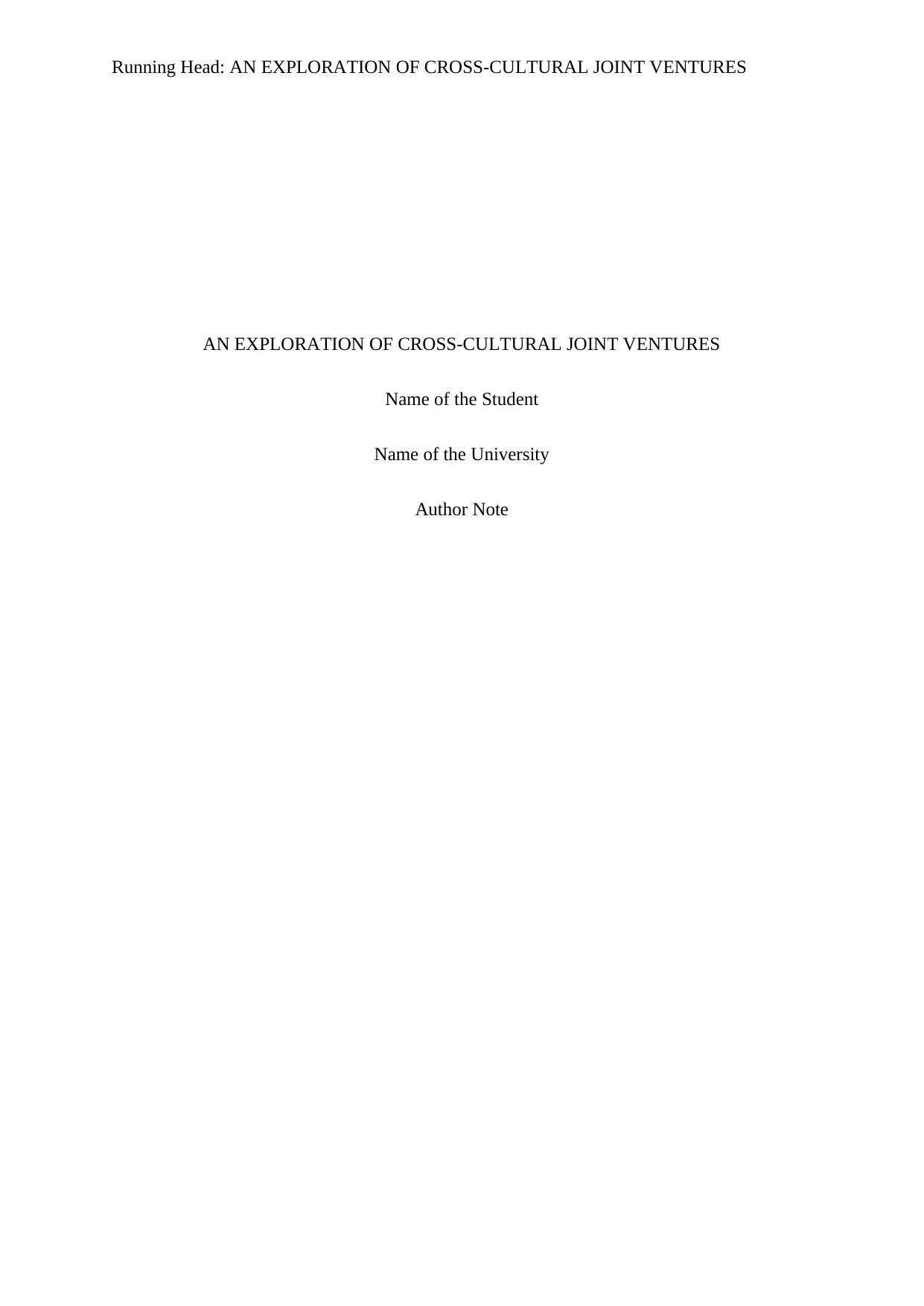
Running Head: AN EXPLORATION OF CROSS-CULTURAL JOINT VENTURES
AN EXPLORATION OF CROSS-CULTURAL JOINT VENTURES
Name of the Student
Name of the University
Author Note
AN EXPLORATION OF CROSS-CULTURAL JOINT VENTURES
Name of the Student
Name of the University
Author Note
Paraphrase This Document
Need a fresh take? Get an instant paraphrase of this document with our AI Paraphraser
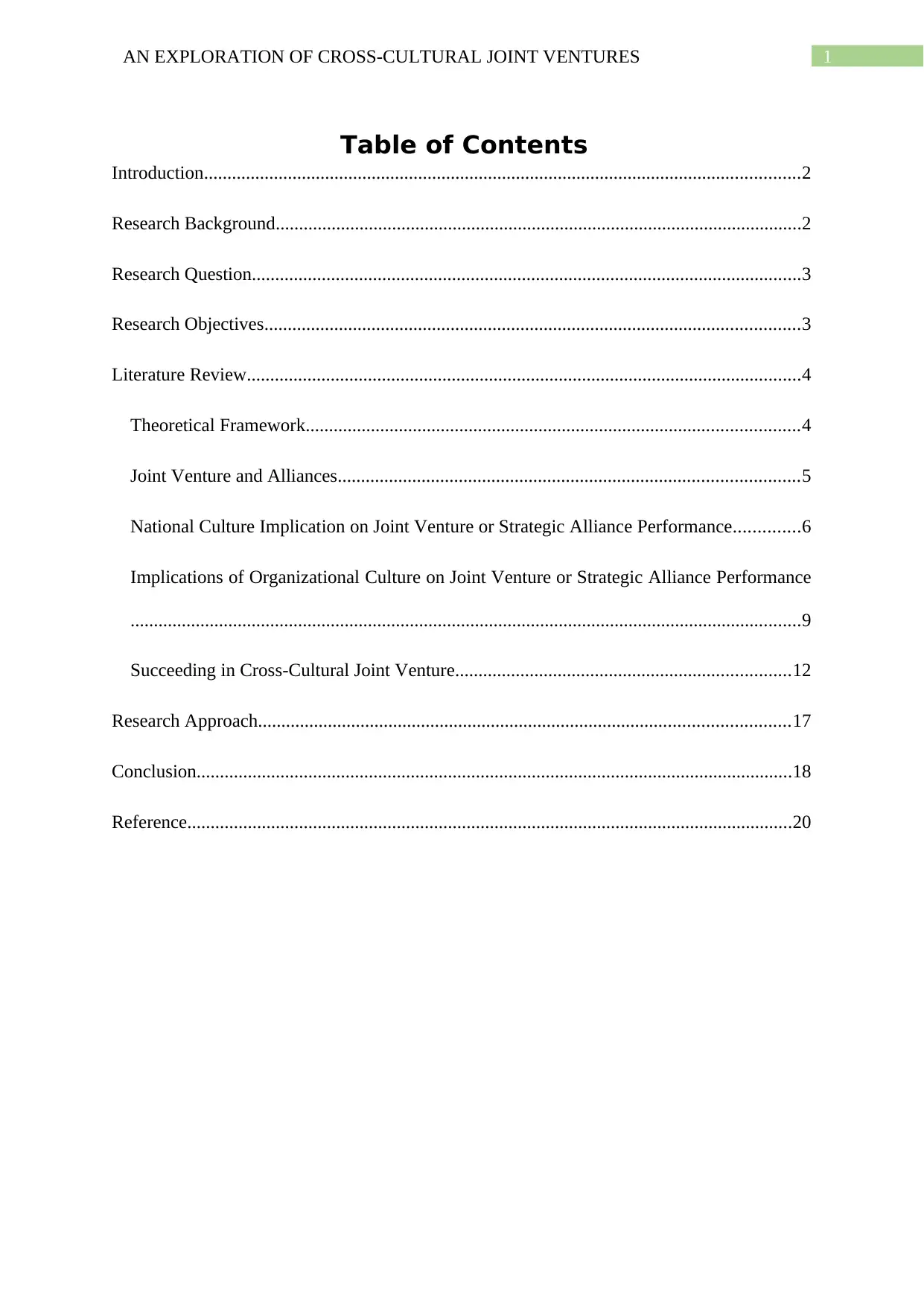
1AN EXPLORATION OF CROSS-CULTURAL JOINT VENTURES
Table of Contents
Introduction................................................................................................................................2
Research Background.................................................................................................................2
Research Question......................................................................................................................3
Research Objectives...................................................................................................................3
Literature Review.......................................................................................................................4
Theoretical Framework..........................................................................................................4
Joint Venture and Alliances...................................................................................................5
National Culture Implication on Joint Venture or Strategic Alliance Performance..............6
Implications of Organizational Culture on Joint Venture or Strategic Alliance Performance
................................................................................................................................................9
Succeeding in Cross-Cultural Joint Venture........................................................................12
Research Approach..................................................................................................................17
Conclusion................................................................................................................................18
Reference..................................................................................................................................20
Table of Contents
Introduction................................................................................................................................2
Research Background.................................................................................................................2
Research Question......................................................................................................................3
Research Objectives...................................................................................................................3
Literature Review.......................................................................................................................4
Theoretical Framework..........................................................................................................4
Joint Venture and Alliances...................................................................................................5
National Culture Implication on Joint Venture or Strategic Alliance Performance..............6
Implications of Organizational Culture on Joint Venture or Strategic Alliance Performance
................................................................................................................................................9
Succeeding in Cross-Cultural Joint Venture........................................................................12
Research Approach..................................................................................................................17
Conclusion................................................................................................................................18
Reference..................................................................................................................................20
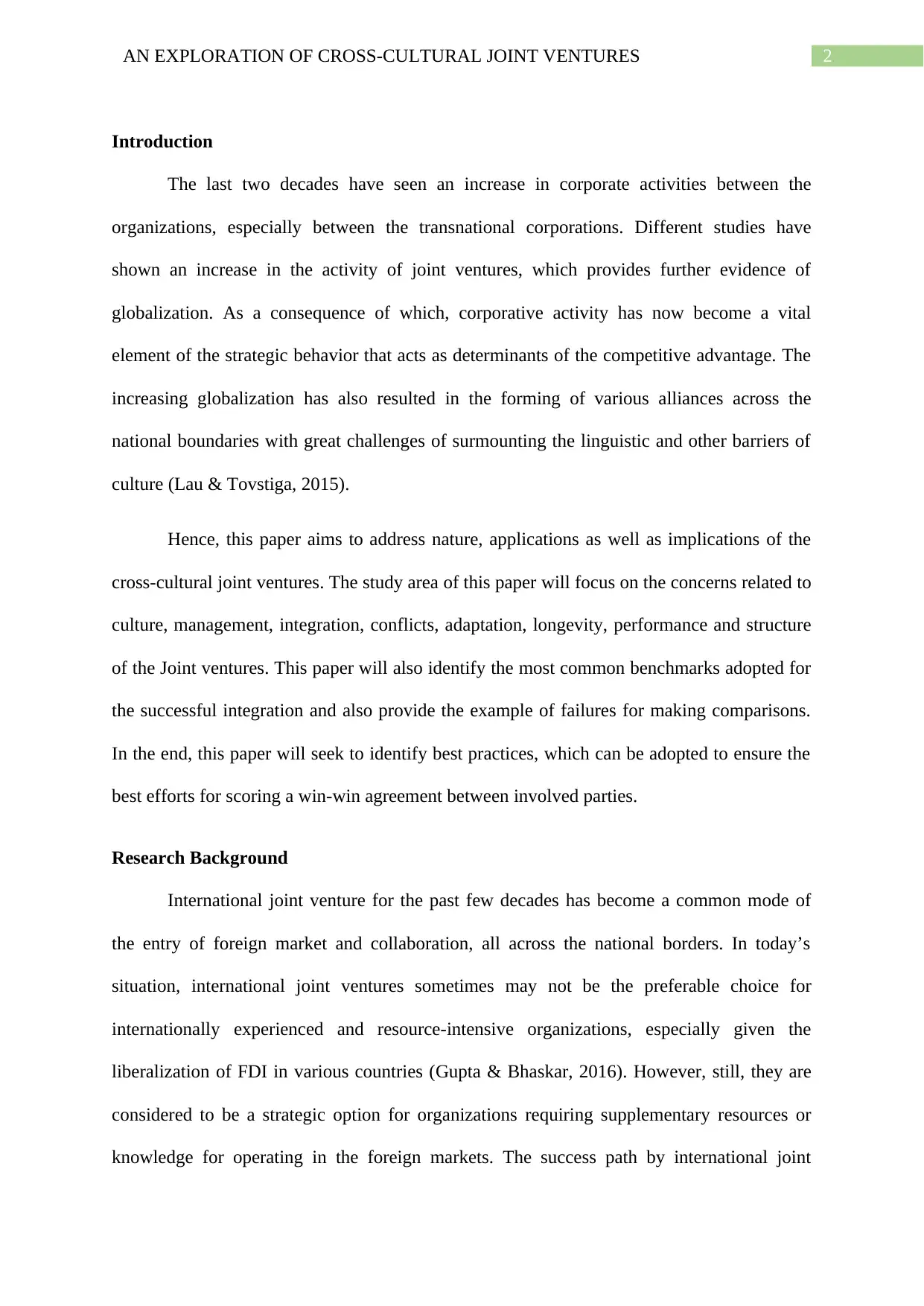
2AN EXPLORATION OF CROSS-CULTURAL JOINT VENTURES
Introduction
The last two decades have seen an increase in corporate activities between the
organizations, especially between the transnational corporations. Different studies have
shown an increase in the activity of joint ventures, which provides further evidence of
globalization. As a consequence of which, corporative activity has now become a vital
element of the strategic behavior that acts as determinants of the competitive advantage. The
increasing globalization has also resulted in the forming of various alliances across the
national boundaries with great challenges of surmounting the linguistic and other barriers of
culture (Lau & Tovstiga, 2015).
Hence, this paper aims to address nature, applications as well as implications of the
cross-cultural joint ventures. The study area of this paper will focus on the concerns related to
culture, management, integration, conflicts, adaptation, longevity, performance and structure
of the Joint ventures. This paper will also identify the most common benchmarks adopted for
the successful integration and also provide the example of failures for making comparisons.
In the end, this paper will seek to identify best practices, which can be adopted to ensure the
best efforts for scoring a win-win agreement between involved parties.
Research Background
International joint venture for the past few decades has become a common mode of
the entry of foreign market and collaboration, all across the national borders. In today’s
situation, international joint ventures sometimes may not be the preferable choice for
internationally experienced and resource-intensive organizations, especially given the
liberalization of FDI in various countries (Gupta & Bhaskar, 2016). However, still, they are
considered to be a strategic option for organizations requiring supplementary resources or
knowledge for operating in the foreign markets. The success path by international joint
Introduction
The last two decades have seen an increase in corporate activities between the
organizations, especially between the transnational corporations. Different studies have
shown an increase in the activity of joint ventures, which provides further evidence of
globalization. As a consequence of which, corporative activity has now become a vital
element of the strategic behavior that acts as determinants of the competitive advantage. The
increasing globalization has also resulted in the forming of various alliances across the
national boundaries with great challenges of surmounting the linguistic and other barriers of
culture (Lau & Tovstiga, 2015).
Hence, this paper aims to address nature, applications as well as implications of the
cross-cultural joint ventures. The study area of this paper will focus on the concerns related to
culture, management, integration, conflicts, adaptation, longevity, performance and structure
of the Joint ventures. This paper will also identify the most common benchmarks adopted for
the successful integration and also provide the example of failures for making comparisons.
In the end, this paper will seek to identify best practices, which can be adopted to ensure the
best efforts for scoring a win-win agreement between involved parties.
Research Background
International joint venture for the past few decades has become a common mode of
the entry of foreign market and collaboration, all across the national borders. In today’s
situation, international joint ventures sometimes may not be the preferable choice for
internationally experienced and resource-intensive organizations, especially given the
liberalization of FDI in various countries (Gupta & Bhaskar, 2016). However, still, they are
considered to be a strategic option for organizations requiring supplementary resources or
knowledge for operating in the foreign markets. The success path by international joint
⊘ This is a preview!⊘
Do you want full access?
Subscribe today to unlock all pages.

Trusted by 1+ million students worldwide
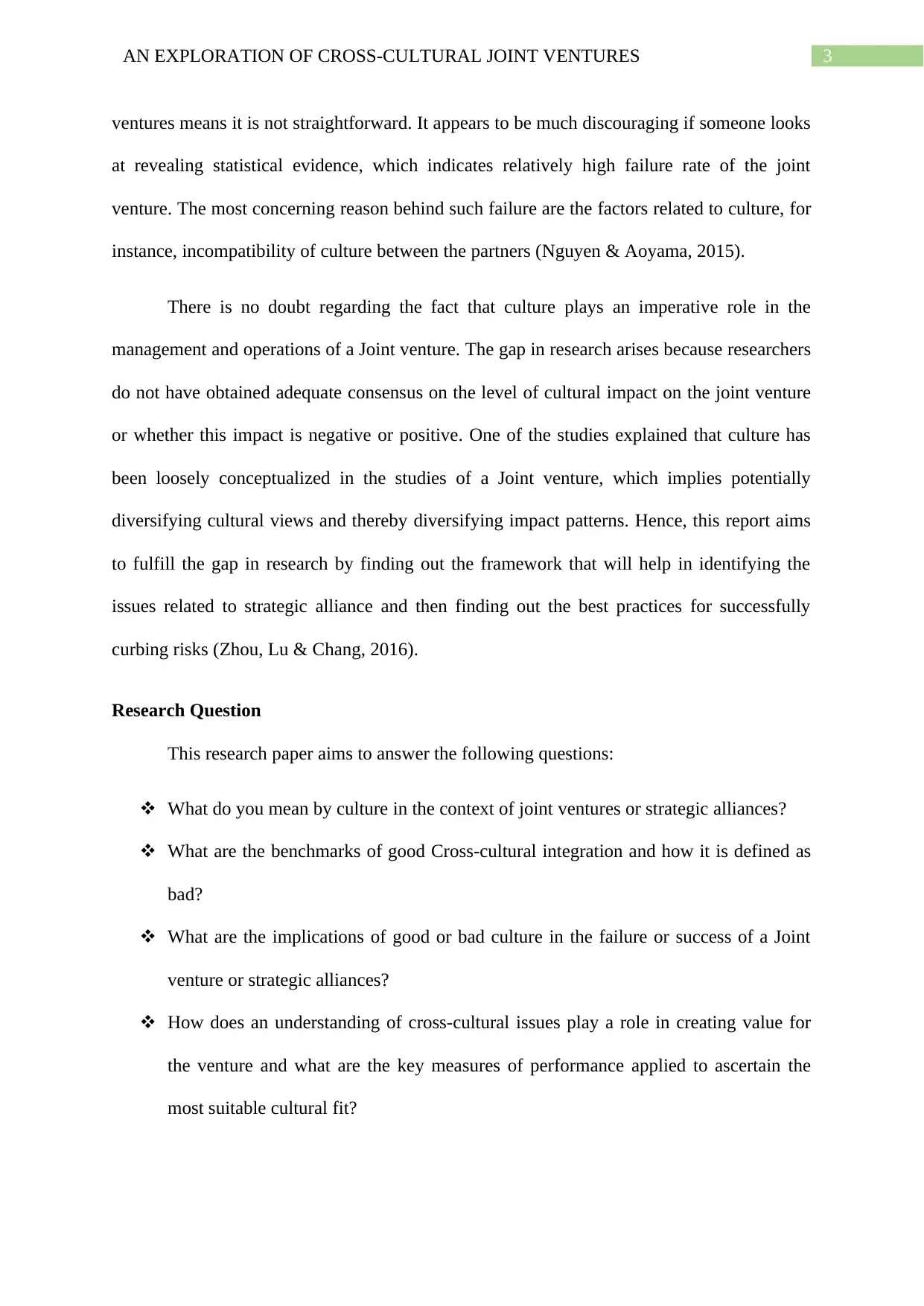
3AN EXPLORATION OF CROSS-CULTURAL JOINT VENTURES
ventures means it is not straightforward. It appears to be much discouraging if someone looks
at revealing statistical evidence, which indicates relatively high failure rate of the joint
venture. The most concerning reason behind such failure are the factors related to culture, for
instance, incompatibility of culture between the partners (Nguyen & Aoyama, 2015).
There is no doubt regarding the fact that culture plays an imperative role in the
management and operations of a Joint venture. The gap in research arises because researchers
do not have obtained adequate consensus on the level of cultural impact on the joint venture
or whether this impact is negative or positive. One of the studies explained that culture has
been loosely conceptualized in the studies of a Joint venture, which implies potentially
diversifying cultural views and thereby diversifying impact patterns. Hence, this report aims
to fulfill the gap in research by finding out the framework that will help in identifying the
issues related to strategic alliance and then finding out the best practices for successfully
curbing risks (Zhou, Lu & Chang, 2016).
Research Question
This research paper aims to answer the following questions:
What do you mean by culture in the context of joint ventures or strategic alliances?
What are the benchmarks of good Cross-cultural integration and how it is defined as
bad?
What are the implications of good or bad culture in the failure or success of a Joint
venture or strategic alliances?
How does an understanding of cross-cultural issues play a role in creating value for
the venture and what are the key measures of performance applied to ascertain the
most suitable cultural fit?
ventures means it is not straightforward. It appears to be much discouraging if someone looks
at revealing statistical evidence, which indicates relatively high failure rate of the joint
venture. The most concerning reason behind such failure are the factors related to culture, for
instance, incompatibility of culture between the partners (Nguyen & Aoyama, 2015).
There is no doubt regarding the fact that culture plays an imperative role in the
management and operations of a Joint venture. The gap in research arises because researchers
do not have obtained adequate consensus on the level of cultural impact on the joint venture
or whether this impact is negative or positive. One of the studies explained that culture has
been loosely conceptualized in the studies of a Joint venture, which implies potentially
diversifying cultural views and thereby diversifying impact patterns. Hence, this report aims
to fulfill the gap in research by finding out the framework that will help in identifying the
issues related to strategic alliance and then finding out the best practices for successfully
curbing risks (Zhou, Lu & Chang, 2016).
Research Question
This research paper aims to answer the following questions:
What do you mean by culture in the context of joint ventures or strategic alliances?
What are the benchmarks of good Cross-cultural integration and how it is defined as
bad?
What are the implications of good or bad culture in the failure or success of a Joint
venture or strategic alliances?
How does an understanding of cross-cultural issues play a role in creating value for
the venture and what are the key measures of performance applied to ascertain the
most suitable cultural fit?
Paraphrase This Document
Need a fresh take? Get an instant paraphrase of this document with our AI Paraphraser
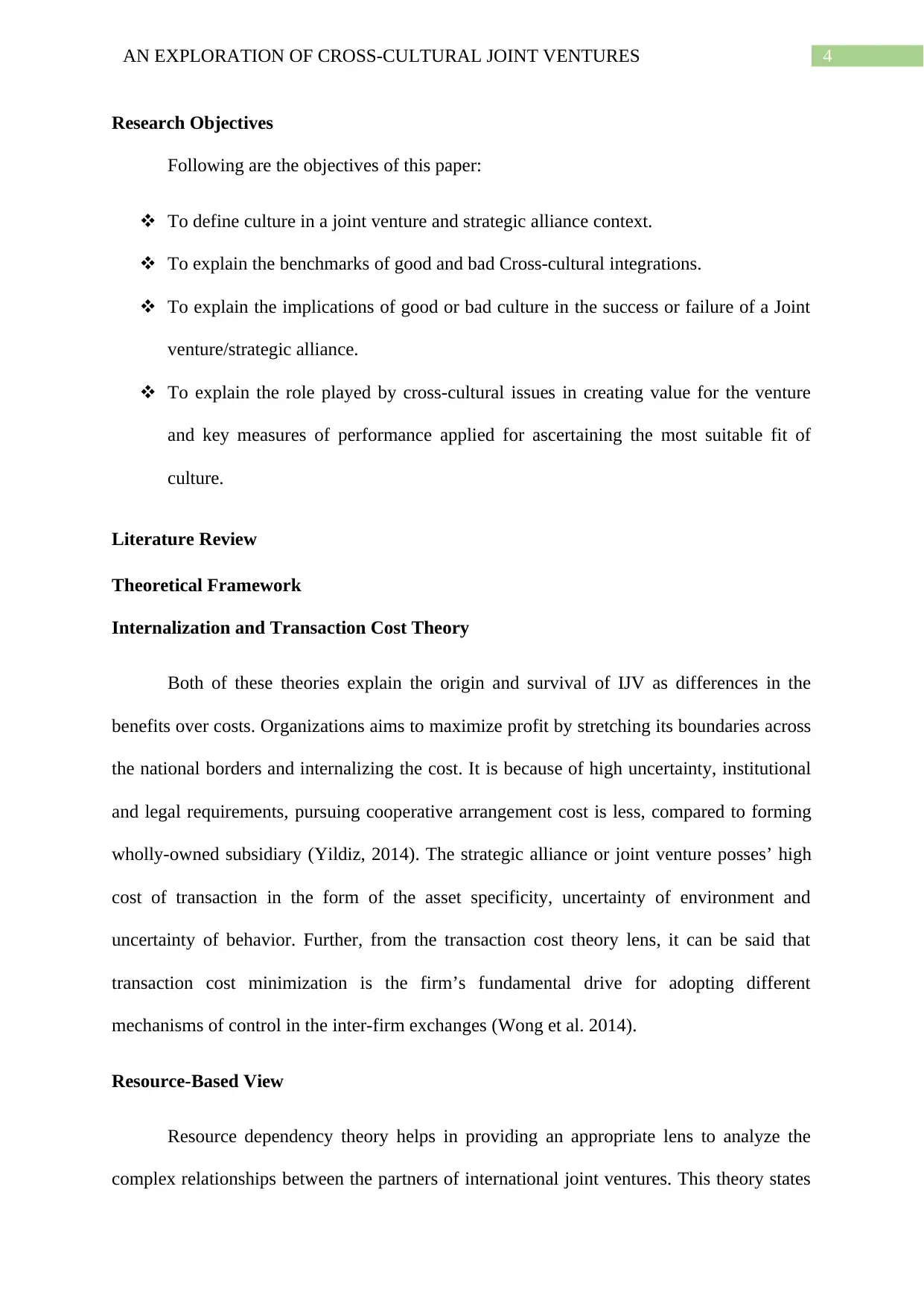
4AN EXPLORATION OF CROSS-CULTURAL JOINT VENTURES
Research Objectives
Following are the objectives of this paper:
To define culture in a joint venture and strategic alliance context.
To explain the benchmarks of good and bad Cross-cultural integrations.
To explain the implications of good or bad culture in the success or failure of a Joint
venture/strategic alliance.
To explain the role played by cross-cultural issues in creating value for the venture
and key measures of performance applied for ascertaining the most suitable fit of
culture.
Literature Review
Theoretical Framework
Internalization and Transaction Cost Theory
Both of these theories explain the origin and survival of IJV as differences in the
benefits over costs. Organizations aims to maximize profit by stretching its boundaries across
the national borders and internalizing the cost. It is because of high uncertainty, institutional
and legal requirements, pursuing cooperative arrangement cost is less, compared to forming
wholly-owned subsidiary (Yildiz, 2014). The strategic alliance or joint venture posses’ high
cost of transaction in the form of the asset specificity, uncertainty of environment and
uncertainty of behavior. Further, from the transaction cost theory lens, it can be said that
transaction cost minimization is the firm’s fundamental drive for adopting different
mechanisms of control in the inter-firm exchanges (Wong et al. 2014).
Resource-Based View
Resource dependency theory helps in providing an appropriate lens to analyze the
complex relationships between the partners of international joint ventures. This theory states
Research Objectives
Following are the objectives of this paper:
To define culture in a joint venture and strategic alliance context.
To explain the benchmarks of good and bad Cross-cultural integrations.
To explain the implications of good or bad culture in the success or failure of a Joint
venture/strategic alliance.
To explain the role played by cross-cultural issues in creating value for the venture
and key measures of performance applied for ascertaining the most suitable fit of
culture.
Literature Review
Theoretical Framework
Internalization and Transaction Cost Theory
Both of these theories explain the origin and survival of IJV as differences in the
benefits over costs. Organizations aims to maximize profit by stretching its boundaries across
the national borders and internalizing the cost. It is because of high uncertainty, institutional
and legal requirements, pursuing cooperative arrangement cost is less, compared to forming
wholly-owned subsidiary (Yildiz, 2014). The strategic alliance or joint venture posses’ high
cost of transaction in the form of the asset specificity, uncertainty of environment and
uncertainty of behavior. Further, from the transaction cost theory lens, it can be said that
transaction cost minimization is the firm’s fundamental drive for adopting different
mechanisms of control in the inter-firm exchanges (Wong et al. 2014).
Resource-Based View
Resource dependency theory helps in providing an appropriate lens to analyze the
complex relationships between the partners of international joint ventures. This theory states
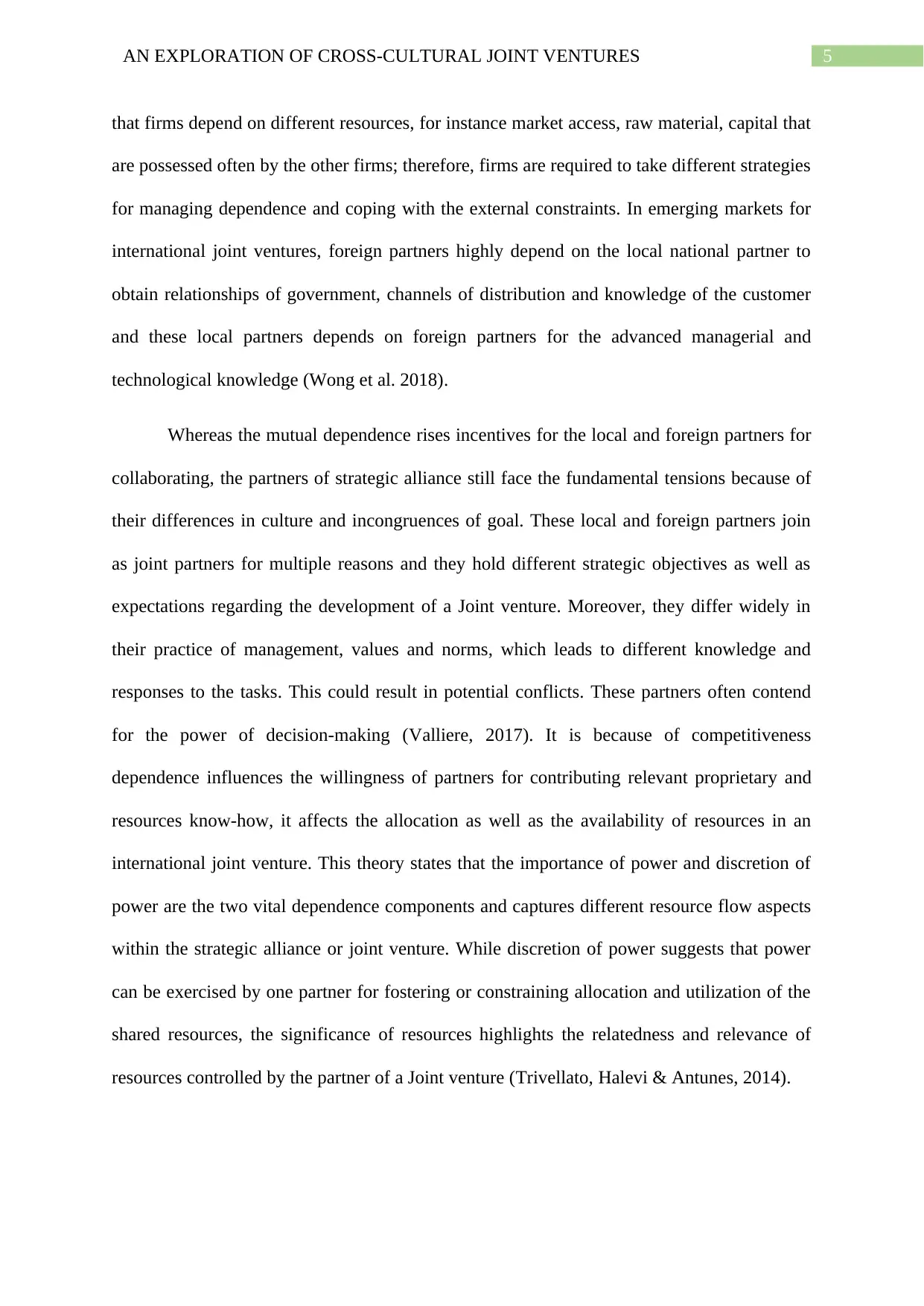
5AN EXPLORATION OF CROSS-CULTURAL JOINT VENTURES
that firms depend on different resources, for instance market access, raw material, capital that
are possessed often by the other firms; therefore, firms are required to take different strategies
for managing dependence and coping with the external constraints. In emerging markets for
international joint ventures, foreign partners highly depend on the local national partner to
obtain relationships of government, channels of distribution and knowledge of the customer
and these local partners depends on foreign partners for the advanced managerial and
technological knowledge (Wong et al. 2018).
Whereas the mutual dependence rises incentives for the local and foreign partners for
collaborating, the partners of strategic alliance still face the fundamental tensions because of
their differences in culture and incongruences of goal. These local and foreign partners join
as joint partners for multiple reasons and they hold different strategic objectives as well as
expectations regarding the development of a Joint venture. Moreover, they differ widely in
their practice of management, values and norms, which leads to different knowledge and
responses to the tasks. This could result in potential conflicts. These partners often contend
for the power of decision-making (Valliere, 2017). It is because of competitiveness
dependence influences the willingness of partners for contributing relevant proprietary and
resources know-how, it affects the allocation as well as the availability of resources in an
international joint venture. This theory states that the importance of power and discretion of
power are the two vital dependence components and captures different resource flow aspects
within the strategic alliance or joint venture. While discretion of power suggests that power
can be exercised by one partner for fostering or constraining allocation and utilization of the
shared resources, the significance of resources highlights the relatedness and relevance of
resources controlled by the partner of a Joint venture (Trivellato, Halevi & Antunes, 2014).
that firms depend on different resources, for instance market access, raw material, capital that
are possessed often by the other firms; therefore, firms are required to take different strategies
for managing dependence and coping with the external constraints. In emerging markets for
international joint ventures, foreign partners highly depend on the local national partner to
obtain relationships of government, channels of distribution and knowledge of the customer
and these local partners depends on foreign partners for the advanced managerial and
technological knowledge (Wong et al. 2018).
Whereas the mutual dependence rises incentives for the local and foreign partners for
collaborating, the partners of strategic alliance still face the fundamental tensions because of
their differences in culture and incongruences of goal. These local and foreign partners join
as joint partners for multiple reasons and they hold different strategic objectives as well as
expectations regarding the development of a Joint venture. Moreover, they differ widely in
their practice of management, values and norms, which leads to different knowledge and
responses to the tasks. This could result in potential conflicts. These partners often contend
for the power of decision-making (Valliere, 2017). It is because of competitiveness
dependence influences the willingness of partners for contributing relevant proprietary and
resources know-how, it affects the allocation as well as the availability of resources in an
international joint venture. This theory states that the importance of power and discretion of
power are the two vital dependence components and captures different resource flow aspects
within the strategic alliance or joint venture. While discretion of power suggests that power
can be exercised by one partner for fostering or constraining allocation and utilization of the
shared resources, the significance of resources highlights the relatedness and relevance of
resources controlled by the partner of a Joint venture (Trivellato, Halevi & Antunes, 2014).
⊘ This is a preview!⊘
Do you want full access?
Subscribe today to unlock all pages.

Trusted by 1+ million students worldwide
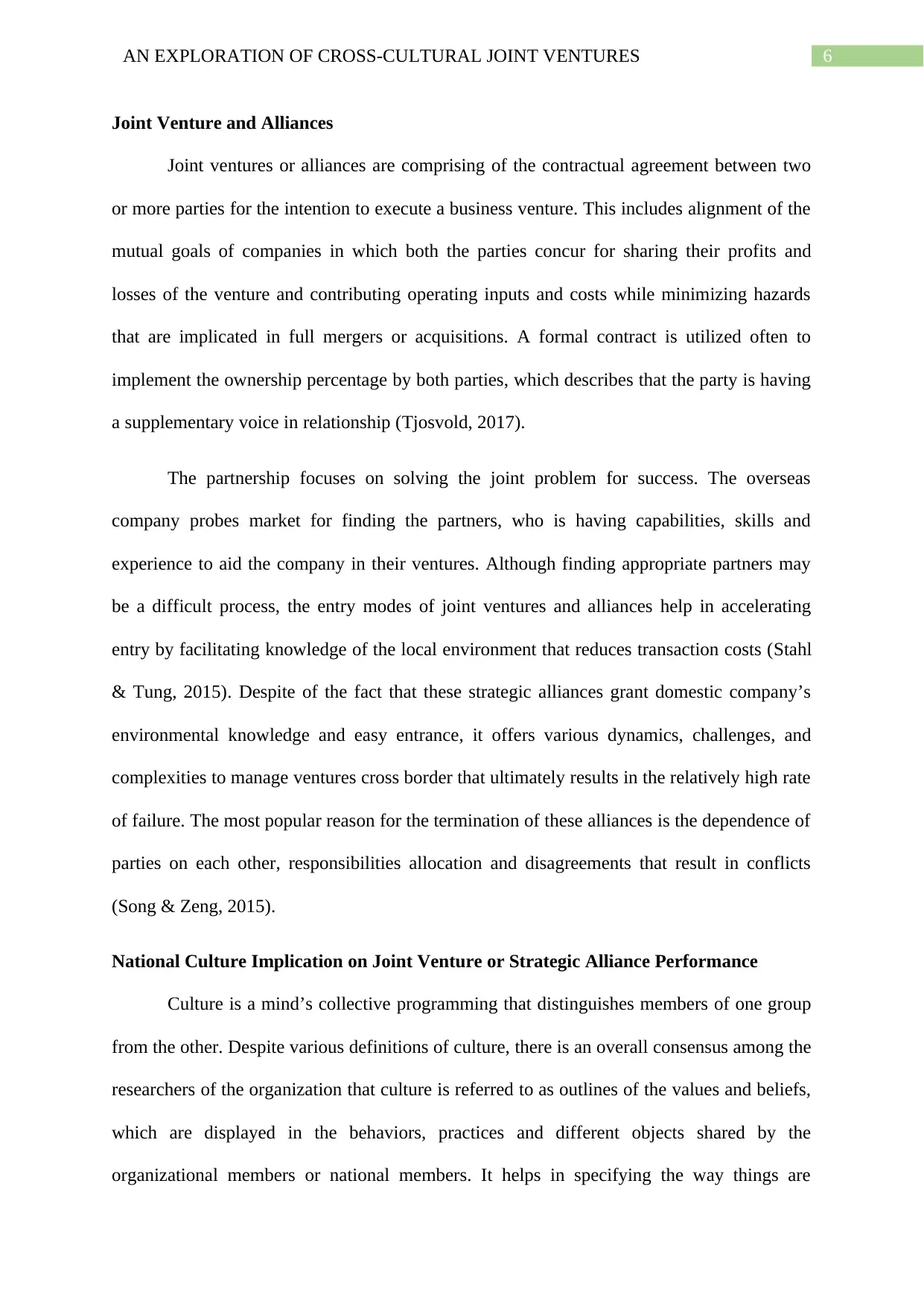
6AN EXPLORATION OF CROSS-CULTURAL JOINT VENTURES
Joint Venture and Alliances
Joint ventures or alliances are comprising of the contractual agreement between two
or more parties for the intention to execute a business venture. This includes alignment of the
mutual goals of companies in which both the parties concur for sharing their profits and
losses of the venture and contributing operating inputs and costs while minimizing hazards
that are implicated in full mergers or acquisitions. A formal contract is utilized often to
implement the ownership percentage by both parties, which describes that the party is having
a supplementary voice in relationship (Tjosvold, 2017).
The partnership focuses on solving the joint problem for success. The overseas
company probes market for finding the partners, who is having capabilities, skills and
experience to aid the company in their ventures. Although finding appropriate partners may
be a difficult process, the entry modes of joint ventures and alliances help in accelerating
entry by facilitating knowledge of the local environment that reduces transaction costs (Stahl
& Tung, 2015). Despite of the fact that these strategic alliances grant domestic company’s
environmental knowledge and easy entrance, it offers various dynamics, challenges, and
complexities to manage ventures cross border that ultimately results in the relatively high rate
of failure. The most popular reason for the termination of these alliances is the dependence of
parties on each other, responsibilities allocation and disagreements that result in conflicts
(Song & Zeng, 2015).
National Culture Implication on Joint Venture or Strategic Alliance Performance
Culture is a mind’s collective programming that distinguishes members of one group
from the other. Despite various definitions of culture, there is an overall consensus among the
researchers of the organization that culture is referred to as outlines of the values and beliefs,
which are displayed in the behaviors, practices and different objects shared by the
organizational members or national members. It helps in specifying the way things are
Joint Venture and Alliances
Joint ventures or alliances are comprising of the contractual agreement between two
or more parties for the intention to execute a business venture. This includes alignment of the
mutual goals of companies in which both the parties concur for sharing their profits and
losses of the venture and contributing operating inputs and costs while minimizing hazards
that are implicated in full mergers or acquisitions. A formal contract is utilized often to
implement the ownership percentage by both parties, which describes that the party is having
a supplementary voice in relationship (Tjosvold, 2017).
The partnership focuses on solving the joint problem for success. The overseas
company probes market for finding the partners, who is having capabilities, skills and
experience to aid the company in their ventures. Although finding appropriate partners may
be a difficult process, the entry modes of joint ventures and alliances help in accelerating
entry by facilitating knowledge of the local environment that reduces transaction costs (Stahl
& Tung, 2015). Despite of the fact that these strategic alliances grant domestic company’s
environmental knowledge and easy entrance, it offers various dynamics, challenges, and
complexities to manage ventures cross border that ultimately results in the relatively high rate
of failure. The most popular reason for the termination of these alliances is the dependence of
parties on each other, responsibilities allocation and disagreements that result in conflicts
(Song & Zeng, 2015).
National Culture Implication on Joint Venture or Strategic Alliance Performance
Culture is a mind’s collective programming that distinguishes members of one group
from the other. Despite various definitions of culture, there is an overall consensus among the
researchers of the organization that culture is referred to as outlines of the values and beliefs,
which are displayed in the behaviors, practices and different objects shared by the
organizational members or national members. It helps in specifying the way things are
Paraphrase This Document
Need a fresh take? Get an instant paraphrase of this document with our AI Paraphraser
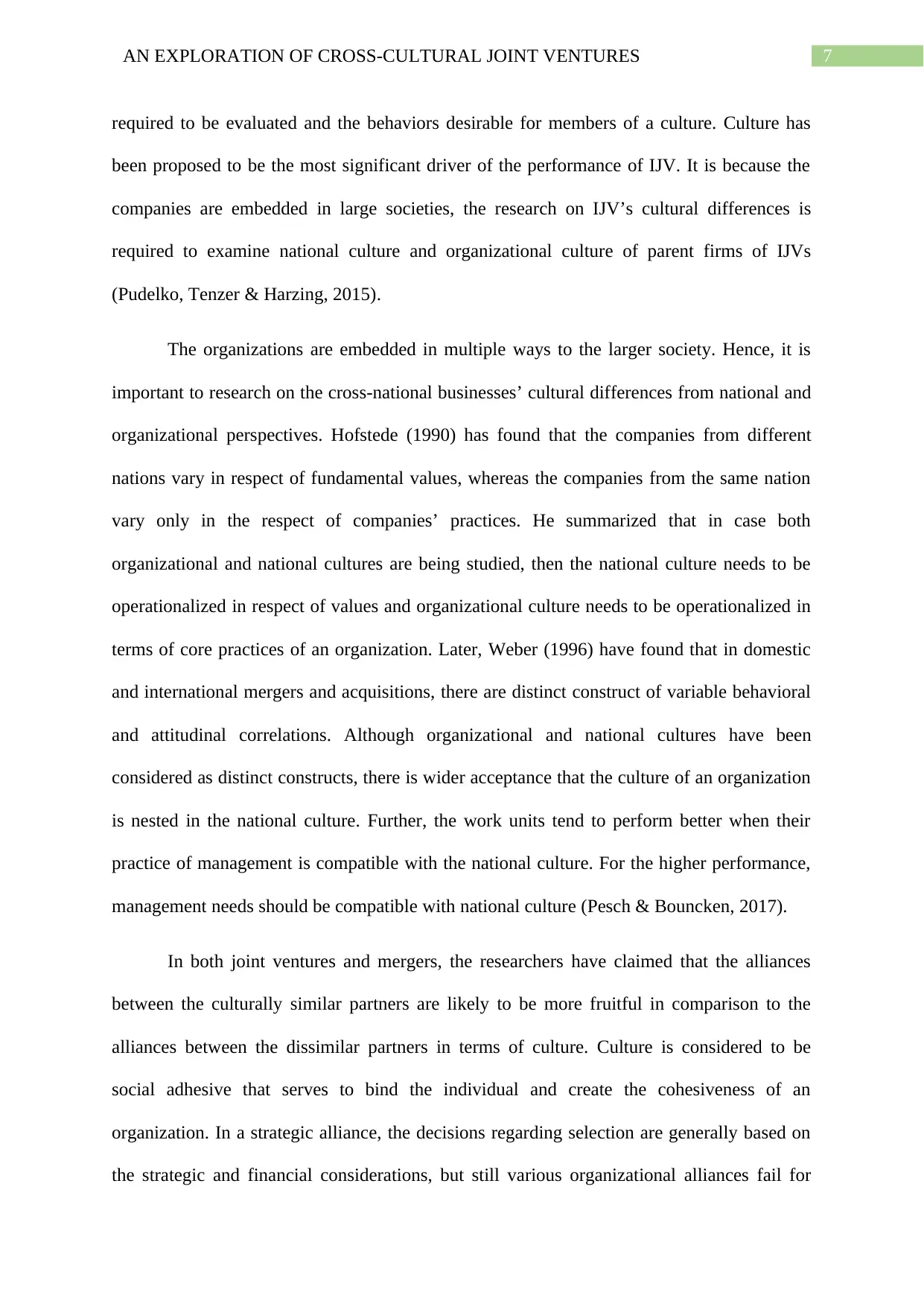
7AN EXPLORATION OF CROSS-CULTURAL JOINT VENTURES
required to be evaluated and the behaviors desirable for members of a culture. Culture has
been proposed to be the most significant driver of the performance of IJV. It is because the
companies are embedded in large societies, the research on IJV’s cultural differences is
required to examine national culture and organizational culture of parent firms of IJVs
(Pudelko, Tenzer & Harzing, 2015).
The organizations are embedded in multiple ways to the larger society. Hence, it is
important to research on the cross-national businesses’ cultural differences from national and
organizational perspectives. Hofstede (1990) has found that the companies from different
nations vary in respect of fundamental values, whereas the companies from the same nation
vary only in the respect of companies’ practices. He summarized that in case both
organizational and national cultures are being studied, then the national culture needs to be
operationalized in respect of values and organizational culture needs to be operationalized in
terms of core practices of an organization. Later, Weber (1996) have found that in domestic
and international mergers and acquisitions, there are distinct construct of variable behavioral
and attitudinal correlations. Although organizational and national cultures have been
considered as distinct constructs, there is wider acceptance that the culture of an organization
is nested in the national culture. Further, the work units tend to perform better when their
practice of management is compatible with the national culture. For the higher performance,
management needs should be compatible with national culture (Pesch & Bouncken, 2017).
In both joint ventures and mergers, the researchers have claimed that the alliances
between the culturally similar partners are likely to be more fruitful in comparison to the
alliances between the dissimilar partners in terms of culture. Culture is considered to be
social adhesive that serves to bind the individual and create the cohesiveness of an
organization. In a strategic alliance, the decisions regarding selection are generally based on
the strategic and financial considerations, but still various organizational alliances fail for
required to be evaluated and the behaviors desirable for members of a culture. Culture has
been proposed to be the most significant driver of the performance of IJV. It is because the
companies are embedded in large societies, the research on IJV’s cultural differences is
required to examine national culture and organizational culture of parent firms of IJVs
(Pudelko, Tenzer & Harzing, 2015).
The organizations are embedded in multiple ways to the larger society. Hence, it is
important to research on the cross-national businesses’ cultural differences from national and
organizational perspectives. Hofstede (1990) has found that the companies from different
nations vary in respect of fundamental values, whereas the companies from the same nation
vary only in the respect of companies’ practices. He summarized that in case both
organizational and national cultures are being studied, then the national culture needs to be
operationalized in respect of values and organizational culture needs to be operationalized in
terms of core practices of an organization. Later, Weber (1996) have found that in domestic
and international mergers and acquisitions, there are distinct construct of variable behavioral
and attitudinal correlations. Although organizational and national cultures have been
considered as distinct constructs, there is wider acceptance that the culture of an organization
is nested in the national culture. Further, the work units tend to perform better when their
practice of management is compatible with the national culture. For the higher performance,
management needs should be compatible with national culture (Pesch & Bouncken, 2017).
In both joint ventures and mergers, the researchers have claimed that the alliances
between the culturally similar partners are likely to be more fruitful in comparison to the
alliances between the dissimilar partners in terms of culture. Culture is considered to be
social adhesive that serves to bind the individual and create the cohesiveness of an
organization. In a strategic alliance, the decisions regarding selection are generally based on
the strategic and financial considerations, but still various organizational alliances fail for
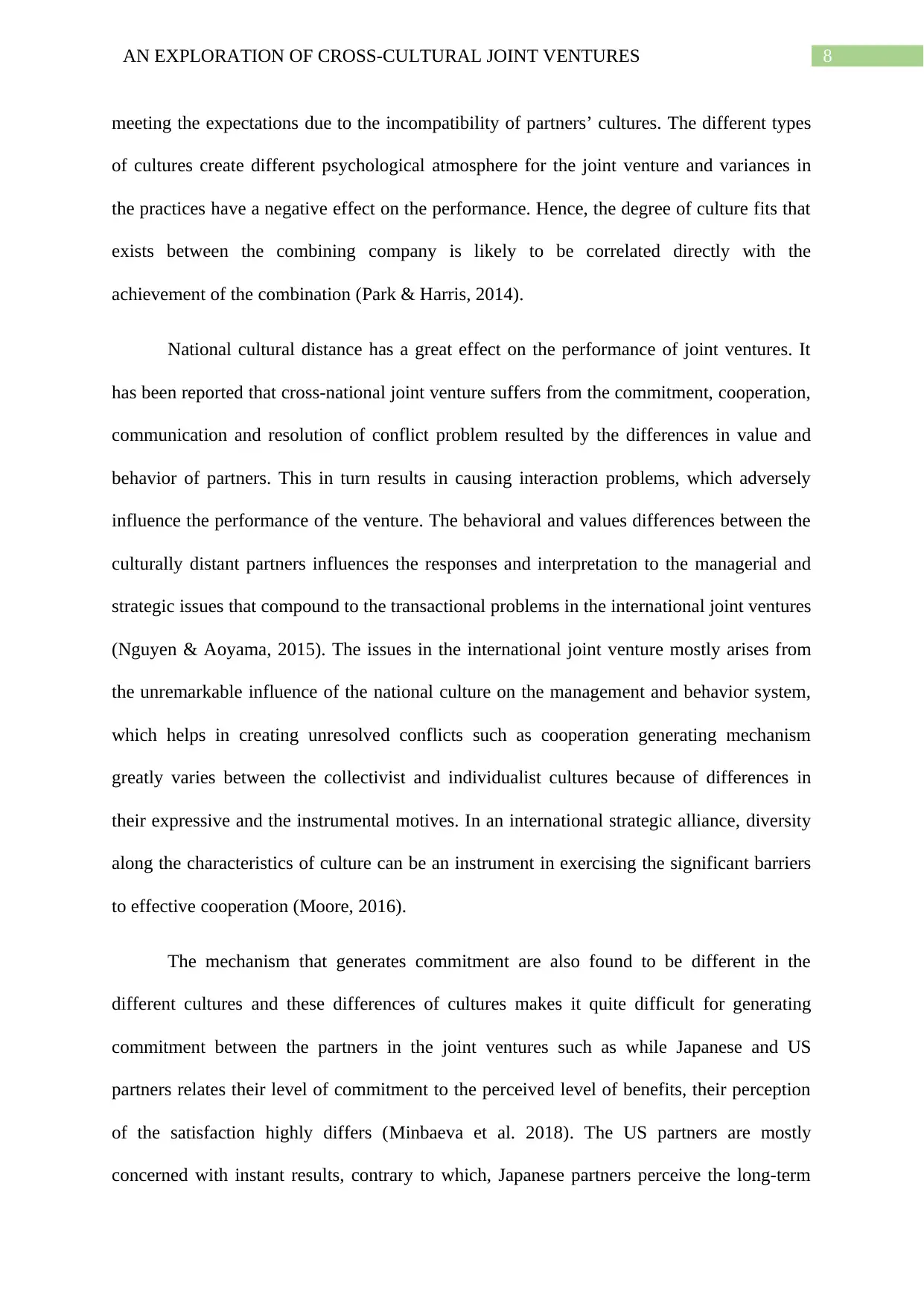
8AN EXPLORATION OF CROSS-CULTURAL JOINT VENTURES
meeting the expectations due to the incompatibility of partners’ cultures. The different types
of cultures create different psychological atmosphere for the joint venture and variances in
the practices have a negative effect on the performance. Hence, the degree of culture fits that
exists between the combining company is likely to be correlated directly with the
achievement of the combination (Park & Harris, 2014).
National cultural distance has a great effect on the performance of joint ventures. It
has been reported that cross-national joint venture suffers from the commitment, cooperation,
communication and resolution of conflict problem resulted by the differences in value and
behavior of partners. This in turn results in causing interaction problems, which adversely
influence the performance of the venture. The behavioral and values differences between the
culturally distant partners influences the responses and interpretation to the managerial and
strategic issues that compound to the transactional problems in the international joint ventures
(Nguyen & Aoyama, 2015). The issues in the international joint venture mostly arises from
the unremarkable influence of the national culture on the management and behavior system,
which helps in creating unresolved conflicts such as cooperation generating mechanism
greatly varies between the collectivist and individualist cultures because of differences in
their expressive and the instrumental motives. In an international strategic alliance, diversity
along the characteristics of culture can be an instrument in exercising the significant barriers
to effective cooperation (Moore, 2016).
The mechanism that generates commitment are also found to be different in the
different cultures and these differences of cultures makes it quite difficult for generating
commitment between the partners in the joint ventures such as while Japanese and US
partners relates their level of commitment to the perceived level of benefits, their perception
of the satisfaction highly differs (Minbaeva et al. 2018). The US partners are mostly
concerned with instant results, contrary to which, Japanese partners perceive the long-term
meeting the expectations due to the incompatibility of partners’ cultures. The different types
of cultures create different psychological atmosphere for the joint venture and variances in
the practices have a negative effect on the performance. Hence, the degree of culture fits that
exists between the combining company is likely to be correlated directly with the
achievement of the combination (Park & Harris, 2014).
National cultural distance has a great effect on the performance of joint ventures. It
has been reported that cross-national joint venture suffers from the commitment, cooperation,
communication and resolution of conflict problem resulted by the differences in value and
behavior of partners. This in turn results in causing interaction problems, which adversely
influence the performance of the venture. The behavioral and values differences between the
culturally distant partners influences the responses and interpretation to the managerial and
strategic issues that compound to the transactional problems in the international joint ventures
(Nguyen & Aoyama, 2015). The issues in the international joint venture mostly arises from
the unremarkable influence of the national culture on the management and behavior system,
which helps in creating unresolved conflicts such as cooperation generating mechanism
greatly varies between the collectivist and individualist cultures because of differences in
their expressive and the instrumental motives. In an international strategic alliance, diversity
along the characteristics of culture can be an instrument in exercising the significant barriers
to effective cooperation (Moore, 2016).
The mechanism that generates commitment are also found to be different in the
different cultures and these differences of cultures makes it quite difficult for generating
commitment between the partners in the joint ventures such as while Japanese and US
partners relates their level of commitment to the perceived level of benefits, their perception
of the satisfaction highly differs (Minbaeva et al. 2018). The US partners are mostly
concerned with instant results, contrary to which, Japanese partners perceive the long-term
⊘ This is a preview!⊘
Do you want full access?
Subscribe today to unlock all pages.

Trusted by 1+ million students worldwide
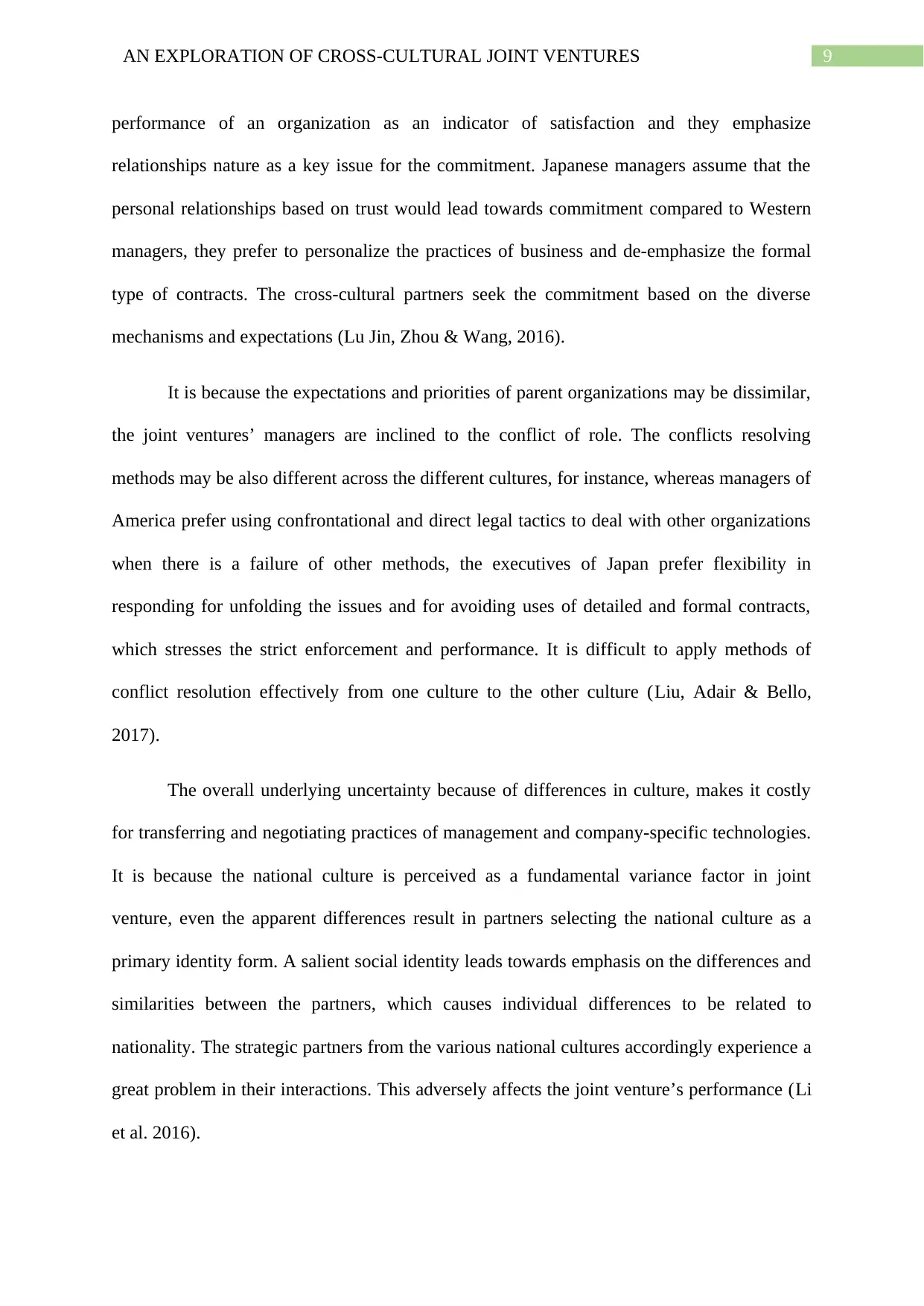
9AN EXPLORATION OF CROSS-CULTURAL JOINT VENTURES
performance of an organization as an indicator of satisfaction and they emphasize
relationships nature as a key issue for the commitment. Japanese managers assume that the
personal relationships based on trust would lead towards commitment compared to Western
managers, they prefer to personalize the practices of business and de-emphasize the formal
type of contracts. The cross-cultural partners seek the commitment based on the diverse
mechanisms and expectations (Lu Jin, Zhou & Wang, 2016).
It is because the expectations and priorities of parent organizations may be dissimilar,
the joint ventures’ managers are inclined to the conflict of role. The conflicts resolving
methods may be also different across the different cultures, for instance, whereas managers of
America prefer using confrontational and direct legal tactics to deal with other organizations
when there is a failure of other methods, the executives of Japan prefer flexibility in
responding for unfolding the issues and for avoiding uses of detailed and formal contracts,
which stresses the strict enforcement and performance. It is difficult to apply methods of
conflict resolution effectively from one culture to the other culture (Liu, Adair & Bello,
2017).
The overall underlying uncertainty because of differences in culture, makes it costly
for transferring and negotiating practices of management and company-specific technologies.
It is because the national culture is perceived as a fundamental variance factor in joint
venture, even the apparent differences result in partners selecting the national culture as a
primary identity form. A salient social identity leads towards emphasis on the differences and
similarities between the partners, which causes individual differences to be related to
nationality. The strategic partners from the various national cultures accordingly experience a
great problem in their interactions. This adversely affects the joint venture’s performance (Li
et al. 2016).
performance of an organization as an indicator of satisfaction and they emphasize
relationships nature as a key issue for the commitment. Japanese managers assume that the
personal relationships based on trust would lead towards commitment compared to Western
managers, they prefer to personalize the practices of business and de-emphasize the formal
type of contracts. The cross-cultural partners seek the commitment based on the diverse
mechanisms and expectations (Lu Jin, Zhou & Wang, 2016).
It is because the expectations and priorities of parent organizations may be dissimilar,
the joint ventures’ managers are inclined to the conflict of role. The conflicts resolving
methods may be also different across the different cultures, for instance, whereas managers of
America prefer using confrontational and direct legal tactics to deal with other organizations
when there is a failure of other methods, the executives of Japan prefer flexibility in
responding for unfolding the issues and for avoiding uses of detailed and formal contracts,
which stresses the strict enforcement and performance. It is difficult to apply methods of
conflict resolution effectively from one culture to the other culture (Liu, Adair & Bello,
2017).
The overall underlying uncertainty because of differences in culture, makes it costly
for transferring and negotiating practices of management and company-specific technologies.
It is because the national culture is perceived as a fundamental variance factor in joint
venture, even the apparent differences result in partners selecting the national culture as a
primary identity form. A salient social identity leads towards emphasis on the differences and
similarities between the partners, which causes individual differences to be related to
nationality. The strategic partners from the various national cultures accordingly experience a
great problem in their interactions. This adversely affects the joint venture’s performance (Li
et al. 2016).
Paraphrase This Document
Need a fresh take? Get an instant paraphrase of this document with our AI Paraphraser
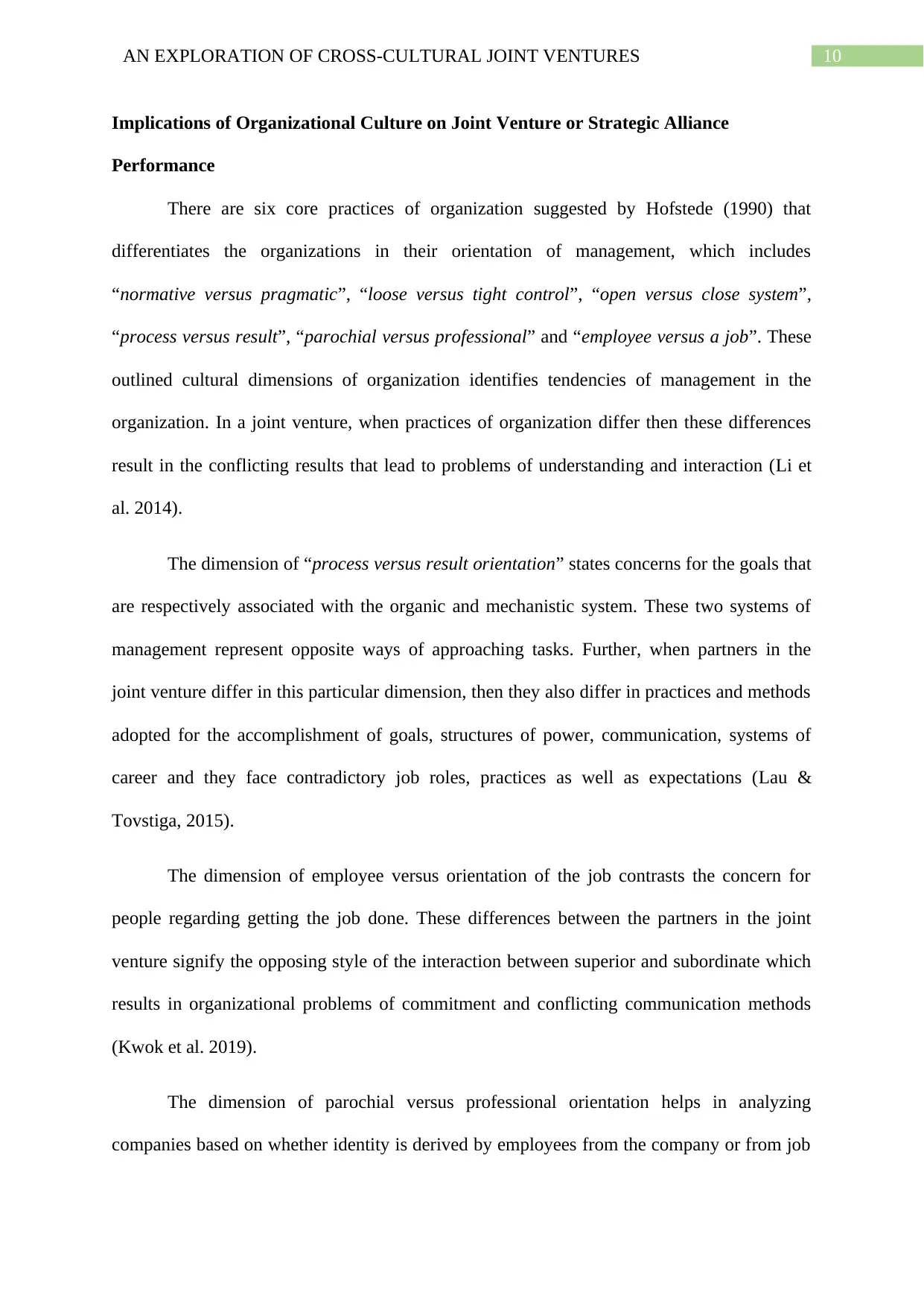
10AN EXPLORATION OF CROSS-CULTURAL JOINT VENTURES
Implications of Organizational Culture on Joint Venture or Strategic Alliance
Performance
There are six core practices of organization suggested by Hofstede (1990) that
differentiates the organizations in their orientation of management, which includes
“normative versus pragmatic”, “loose versus tight control”, “open versus close system”,
“process versus result”, “parochial versus professional” and “employee versus a job”. These
outlined cultural dimensions of organization identifies tendencies of management in the
organization. In a joint venture, when practices of organization differ then these differences
result in the conflicting results that lead to problems of understanding and interaction (Li et
al. 2014).
The dimension of “process versus result orientation” states concerns for the goals that
are respectively associated with the organic and mechanistic system. These two systems of
management represent opposite ways of approaching tasks. Further, when partners in the
joint venture differ in this particular dimension, then they also differ in practices and methods
adopted for the accomplishment of goals, structures of power, communication, systems of
career and they face contradictory job roles, practices as well as expectations (Lau &
Tovstiga, 2015).
The dimension of employee versus orientation of the job contrasts the concern for
people regarding getting the job done. These differences between the partners in the joint
venture signify the opposing style of the interaction between superior and subordinate which
results in organizational problems of commitment and conflicting communication methods
(Kwok et al. 2019).
The dimension of parochial versus professional orientation helps in analyzing
companies based on whether identity is derived by employees from the company or from job
Implications of Organizational Culture on Joint Venture or Strategic Alliance
Performance
There are six core practices of organization suggested by Hofstede (1990) that
differentiates the organizations in their orientation of management, which includes
“normative versus pragmatic”, “loose versus tight control”, “open versus close system”,
“process versus result”, “parochial versus professional” and “employee versus a job”. These
outlined cultural dimensions of organization identifies tendencies of management in the
organization. In a joint venture, when practices of organization differ then these differences
result in the conflicting results that lead to problems of understanding and interaction (Li et
al. 2014).
The dimension of “process versus result orientation” states concerns for the goals that
are respectively associated with the organic and mechanistic system. These two systems of
management represent opposite ways of approaching tasks. Further, when partners in the
joint venture differ in this particular dimension, then they also differ in practices and methods
adopted for the accomplishment of goals, structures of power, communication, systems of
career and they face contradictory job roles, practices as well as expectations (Lau &
Tovstiga, 2015).
The dimension of employee versus orientation of the job contrasts the concern for
people regarding getting the job done. These differences between the partners in the joint
venture signify the opposing style of the interaction between superior and subordinate which
results in organizational problems of commitment and conflicting communication methods
(Kwok et al. 2019).
The dimension of parochial versus professional orientation helps in analyzing
companies based on whether identity is derived by employees from the company or from job
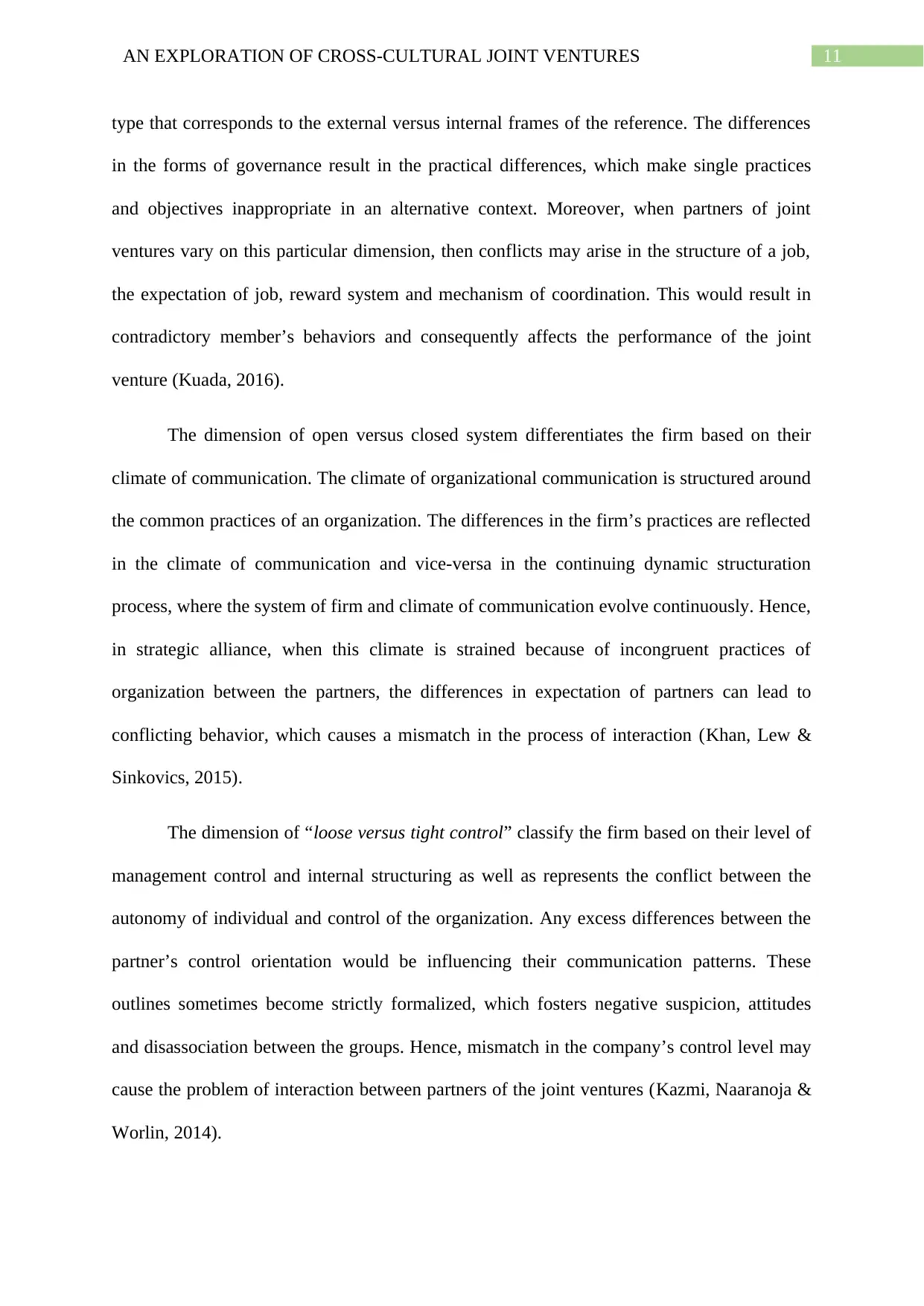
11AN EXPLORATION OF CROSS-CULTURAL JOINT VENTURES
type that corresponds to the external versus internal frames of the reference. The differences
in the forms of governance result in the practical differences, which make single practices
and objectives inappropriate in an alternative context. Moreover, when partners of joint
ventures vary on this particular dimension, then conflicts may arise in the structure of a job,
the expectation of job, reward system and mechanism of coordination. This would result in
contradictory member’s behaviors and consequently affects the performance of the joint
venture (Kuada, 2016).
The dimension of open versus closed system differentiates the firm based on their
climate of communication. The climate of organizational communication is structured around
the common practices of an organization. The differences in the firm’s practices are reflected
in the climate of communication and vice-versa in the continuing dynamic structuration
process, where the system of firm and climate of communication evolve continuously. Hence,
in strategic alliance, when this climate is strained because of incongruent practices of
organization between the partners, the differences in expectation of partners can lead to
conflicting behavior, which causes a mismatch in the process of interaction (Khan, Lew &
Sinkovics, 2015).
The dimension of “loose versus tight control” classify the firm based on their level of
management control and internal structuring as well as represents the conflict between the
autonomy of individual and control of the organization. Any excess differences between the
partner’s control orientation would be influencing their communication patterns. These
outlines sometimes become strictly formalized, which fosters negative suspicion, attitudes
and disassociation between the groups. Hence, mismatch in the company’s control level may
cause the problem of interaction between partners of the joint ventures (Kazmi, Naaranoja &
Worlin, 2014).
type that corresponds to the external versus internal frames of the reference. The differences
in the forms of governance result in the practical differences, which make single practices
and objectives inappropriate in an alternative context. Moreover, when partners of joint
ventures vary on this particular dimension, then conflicts may arise in the structure of a job,
the expectation of job, reward system and mechanism of coordination. This would result in
contradictory member’s behaviors and consequently affects the performance of the joint
venture (Kuada, 2016).
The dimension of open versus closed system differentiates the firm based on their
climate of communication. The climate of organizational communication is structured around
the common practices of an organization. The differences in the firm’s practices are reflected
in the climate of communication and vice-versa in the continuing dynamic structuration
process, where the system of firm and climate of communication evolve continuously. Hence,
in strategic alliance, when this climate is strained because of incongruent practices of
organization between the partners, the differences in expectation of partners can lead to
conflicting behavior, which causes a mismatch in the process of interaction (Khan, Lew &
Sinkovics, 2015).
The dimension of “loose versus tight control” classify the firm based on their level of
management control and internal structuring as well as represents the conflict between the
autonomy of individual and control of the organization. Any excess differences between the
partner’s control orientation would be influencing their communication patterns. These
outlines sometimes become strictly formalized, which fosters negative suspicion, attitudes
and disassociation between the groups. Hence, mismatch in the company’s control level may
cause the problem of interaction between partners of the joint ventures (Kazmi, Naaranoja &
Worlin, 2014).
⊘ This is a preview!⊘
Do you want full access?
Subscribe today to unlock all pages.

Trusted by 1+ million students worldwide
1 out of 26
Related Documents
Your All-in-One AI-Powered Toolkit for Academic Success.
+13062052269
info@desklib.com
Available 24*7 on WhatsApp / Email
![[object Object]](/_next/static/media/star-bottom.7253800d.svg)
Unlock your academic potential
Copyright © 2020–2025 A2Z Services. All Rights Reserved. Developed and managed by ZUCOL.





